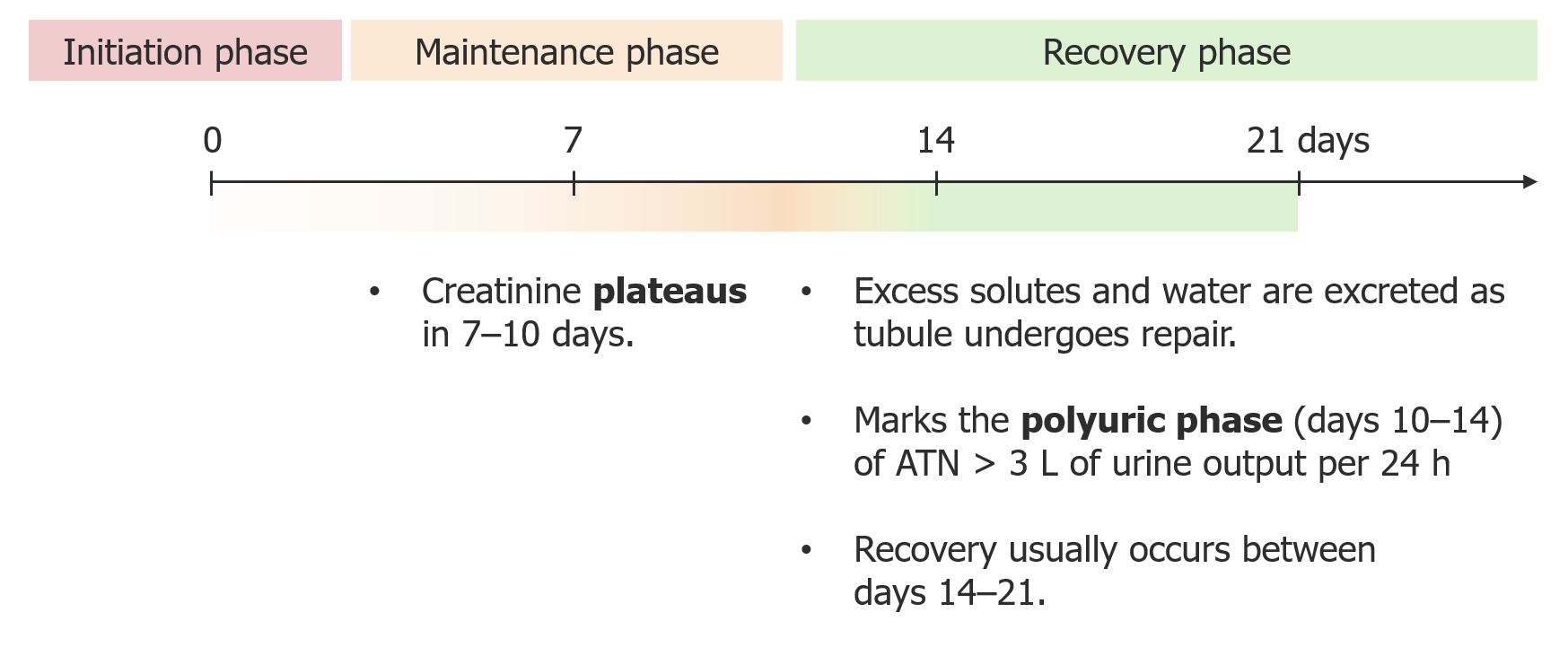Playlist
Show Playlist
Hide Playlist
Pre-renal AKI: Pathophysiology
-
Slides Nephrology Acute Kidney Injury.pdf
-
Reference List Nephrology.pdf
-
Download Lecture Overview
00:01
So let's talk a little bit more about
pre-renal and the causes behind it.
00:07
The two major causes as we've
mentioned before are true volume depletion.
00:12
True volume depletion means that we have a loss
of sodium from the extracellular fluid volume.
00:17
Remember, sodium is the primary
cation that expands that ECF
so it's critical in order to maintain
our volume status to have sodium.
00:27
If we have a situation where our patient has
GI losses, they develop gastroenteritis,
they have significant
emesis or diarrheal losses,
they lose a lot of sodium and
therefore become hypovolemic.
00:39
If our patient loses volume
through hemorrhagic shock,
renal losses if they're on excessive amounts
of diuretics or cutaneous losses with burns,
these can all result in hypovolemia.
00:50
We can also see renal hypoperfusion when there's
a decrease in effective arterial blood volume.
00:56
And when I talk about a decrease in
effective arterial blood volume,
I'm really referring to the extracellular
fluid volume in the arterial circulation.
01:05
So it may be such that our patient's total extracellular
fluid volume is actually high or increased.
01:12
But what's actually circulating in the
arterial volume and perceived by baroreceptors
is actually on the lower side.
01:19
So again, if I have arterial
blood volume that's low,
my baroreceptors in the carotid
sinus, the glomerular afferent arterioles
are very low perceiving that I don't have volume
and this really includes our edematous states.
01:33
That's heart failure, hepatic cirrhosis
and portal hypertension and sepsis.
01:40
So, before we move on, I think
it's really important to talk about
what our kidneys are able to
do in order to maintain our GFR
when we do have a decrease
in renal artery perfusion.
01:51
So if you look at our schematic here on the right, you
can see that we have a picture of our glomerulus.
01:58
We have the afferent
arteriole located at the left.
02:01
We have our glomerular
capillary network in the middle
and then we have our
efferent arteriole on the right.
02:06
And remember that through changes in
the afferent and efferent arteriole,
we can change that hydrostatic
pressure in the glomerular capillary network
and we can change the filtration.
02:16
So when we have a
decrease in renal perfusion,
our bodies are so smart, they develop homeostatic
mechanisms in order to activate and maintain that GFR.
02:26
We do this through the afferent
arteriole that can vasodilate
because of the generation
of vasodilatory prostaglandins.
02:33
We have an increase in vasodilation which can then
increase the glomerular capillary hydrostatic pressure.
02:41
At the efferent arteriole, we
have things like angiotensin II
which can actually cause renal
vasoconstriction of that particular arteriole.
02:50
And again, if I have vasodilation and I have
constriction at the efferent arteriole
then I'm maintaining or increasing my hydrostatic
pressure in the glomerular capillary network.
03:02
When we have this autoregulation
phenomena, we can increase our filtration fraction
leading to an increase in oncotic pressure
in the post glomerular capillaries
with a resultant increase in salt and
water absorption in the proximal tubule.
03:15
Activation of angiotensin
II and antidiuretic hormone
will lead to also an increase
in salt and water absorption
so our patients tend to have a low urine
sodium and a very concentrated urine.
03:30
Now, what happens when our patient
comes in and they're taking a medication
like a non-steroidal anti-inflammatory
drug, something like ibuprofen or Aleve.
03:40
That is going to antagonize those
vasodilatory prostaglandins and therefore
in a situation where a patient is having
a decrease in renal artery perfusion,
we don't have that mechanism
of vasodilation in order to increase
or maintain that glomerular capillary hydrostatic
pressure and that patient will have a reduction in GFR.
04:02
Similarly, what if the patient was
on an ACE inhibitor or an ARB?
Those are fantastic medications but if our patient
is on that medication in the setting of hypovolemia,
then we don't have that autoregulatory
control to constrict the efferent arteriole
again either maintaining or increasing hydrostatic
pressure in that glomerular capillary network
and then we have a resultant fall in GFR.
About the Lecture
The lecture Pre-renal AKI: Pathophysiology by Amy Sussman, MD is from the course Acute Kidney Injury (AKI).
Included Quiz Questions
Which of the following may cause renal hypoperfusion despite increased ECF volume?
- Heart failure
- Hemorrhage
- Diarrhea
- Excessive sweating during exercise
Which of the following would decrease the glomerular filtration rate?
- Action of a prostaglandin antagonist at the afferent arteriole of the glomerulus
- Stopping NSAID use
- Angiotensin II constriction of the efferent arteriole of glomerulus
- Prostaglandin vasodilation of the afferent arteriole of glomerulus
Customer reviews
5,0 of 5 stars
| 5 Stars |
|
2 |
| 4 Stars |
|
0 |
| 3 Stars |
|
0 |
| 2 Stars |
|
0 |
| 1 Star |
|
0 |
Very good explanation and a well understood cause; Good graphic content and dictation.
AWESOME LECTURES!! LOVE THEM!, BEAUTIFUL AND EASY TO UNDERSTAND SCHEMATIC DESCRRIPTION




